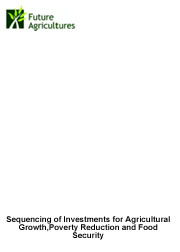{jathumbnail off} As investment in agricultural development gains increasing prominence in Africa, amonggovernments and donors, there is renewed interest in developing strategic understanding of theinvestments that are needed to effectively and efficiently promote agricultural growth to benefit thepoor and improve food security.
As investment in agricultural development gains increasing prominence in Africa, amonggovernments and donors, there is renewed interest in developing strategic understanding of theinvestments that are needed to effectively and efficiently promote agricultural growth to benefit thepoor and improve food security.
This is a matter of particular concern in the design andimplementation of NEPAD’s Comprehensive Africa Agriculture Development Program. NEPADand its partners are therefore planning to establish Regional Strategy and Knowledge SupportSystems (to be called ReSAKSS) to develop information and analytical capabilities to support theprioritization, design, implementation, and monitoring and evaluation of investment programs andactivities.
A meeting was held in Washington in June 2006 to discuss the establishment of theseReSAKSS. Attended by representatives from research institutions, regional economic communities,and donors, the two day meeting discussed first critical analytical issues that these systems andneed to address and process for the successful establishment of these systems. A critical issue for design of investment programmes is to ensure that investments are correctlysequenced.
To understand this, it is a necessary first to understand the major processes and stagesof agricultural development, of economic growth, and of poverty reduction.Agricultural growth, poverty reduction, and food security require complementary changes inpeople’s livelihoods and in the local and national economic environment. Livelihoods can behelpfully considered in terms of their contribution to three broad strategies which we term “hangingin” (maintenance and survival), “stepping up” (improvement and expansion of current activities),and “stepping out” (branching out to new activities).
These strategies are not mutually exclusive:most of us have some concerns to “hang in”, but development involves increasing opportunities for“stepping up” and “stepping out”. These transitions are particularly important to poor rural people,for whom agriculture is a major vehicle for “hanging in”, and, with agricultural growth, for“stepping up”. In the long run, however, agriculture is something from which most people “stepout” to employment in non-farm activities.
The growth of non farm employment opportunities,however, depends upon growth and structural change in the wider economy, including, of course,“stepping up” growth in agriculture.The processes of livelihoods and economic change and growth are highly inter-related anddependent upon each other. They depend upon, and are driven by, technical and institutionalchange which again interact and depend upon each other to raise the productivity of resources andfacilitate capital accumulation. Unfortunately, though, these processes can be impeded by a set ofmicro-, meso-, and macro- poverty traps.
Micro traps are well known, a vicious circle where peoplehave limited resources, which lead to low productivity, which leads to low incomes, which thenprevent the accumulation of resources. The trap is exacerbated by vulnerability to health, climate,and economic stresses and shocks, vulnerability which is increased by the low incomes and limitedresources of poor people.
